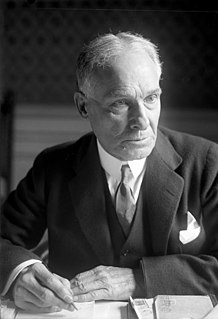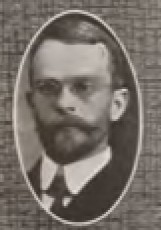
A normal school is an institution created to train teachers by educating them in the norms of pedagogy and curriculum. In the 19th century in the United States,instruction in normal schools was at the high school level,turning out primary school teachers. Most such schools are now called "teacher-training colleges" or "teachers' colleges",require a high school diploma,and may be part of a comprehensive university. Normal schools in the United States,Canada and Argentina trained teachers for primary schools,while in continental Europe,the equivalent colleges educated teachers for primary,secondary and tertiary schools.

Jacob Gould Schurman was a Canadian-born American educator and diplomat,who served as President of Cornell University and United States Ambassador to Germany.

Gilbert Carlton Walker was a United States political figure. He served as the 36th Governor of Virginia,first as a Republican provisional governor between 1869 and 1870,and again as a Democrat elected governor from 1870 to 1874. He was the last Republican governor of Virginia until Linwood Holton took office in 1970.

Hugo Francis Bezdek was a Czech American athlete who played American football and was a coach of football,basketball,and baseball. He was the head football coach at the University of Oregon,the University of Arkansas (1908–1912),Pennsylvania State University (1918–1929),and Delaware Valley College (1949). Bezdek also coached the Mare Island Marines in the 1918 Rose Bowl and the Cleveland Rams of the National Football League (NFL) in 1937 and part of the 1938 season. In addition,Bezdek coached basketball at Oregon and Penn State (1919),coached baseball at Arkansas (1909–1913),Oregon (1914–1917) and Penn State (1920–1930),and served as the manager of Major League Baseball's Pittsburgh Pirates (1917–1919). He was inducted into the College Football Hall of Fame as a coach in 1954.

Kenyon Leech Butterfield was an American agricultural scientist and college administrator known for developing the Cooperative Extension Service at the Land Grant Universities. He was president of the Rhode Island College of Agriculture and Mechanic Arts (1903-1906);the Massachusetts Agricultural College (1906-1924),and the Michigan Agricultural College,from 1924 to 1928.

Francis Julius LeMoyne was a 19th-century American medical doctor and philanthropist from Washington,Pennsylvania. Responsible for creating the first crematory in the United States,he was also an abolitionist,founder of Washington's first public library,co-founder of the Washington Female Seminary,and an instrumental benefactor to the LeMoyne Normal and Commercial School,to which he made a $20,000 donation in 1870.

Lunsford Lindsay Lomax was the fourth president of Virginia Agricultural and Mechanical College and an officer in the United States Army who resigned his commission to join the Confederate Army at the outbreak of the American Civil War. He had maintained a close friendship with his West Point classmate Fitzhugh Lee,and served under him as a brigadier in the Overland Campaign. He was then given command of the Valley District,where he supervised intelligence-gathering operations by Mosby's Rangers.
This is an incomplete list of historic properties and districts at United States colleges and universities that are listed on the National Register of Historic Places (NRHP). This includes National Historic Landmarks (NHLs) and other National Register of Historic Places listings. It includes listings at current and former educational institutions.

The University of Rhode Island (URI) is a public land-grant research university with its main campus in Kingston,Rhode Island,United States. It is the flagship public research as well as the land-grant university of the state of Rhode Island. Its main campus is located in the village of Kingston in southern Rhode Island. Satellite campuses include the Feinstein Campus in Downtown Providence,the Rhode Island Nursing Education Center in Providence's Jewelry District,the Narragansett Bay Campus in Narragansett,and the W. Alton Jones Campus in West Greenwich.

Jonathan Maxcy was an American Baptist minister and college president. He was the second president of Brown University,of which he was also a graduate;the third president of Union College;and the first president of the University of South Carolina.

William F. Edwards was a prominent businessman and educator who held the Driggs Chair of Finance at Brigham Young University (BYU) among many other notable positions.

John Barlow was an American entomologist and college administrator. For 35 years,he was the chairman of the Zoology Department of Rhode Island State College and was twice interim president of the college.

Oscar William Rackle was an American basketball player and coach. He was a multi-sport athlete at Brown University from 1902 to 1906. He later served as head coach of the 1910–11 Indiana Hoosiers men's basketball team.

William H. Taylor was a Vermont attorney,politician,and judge. He was notable for his service as an associate justice of the Vermont Supreme Court from 1913 to 1926.
Howard Rusk Long was an American journalist and writer. He was the manager of the Missouri Press Association,and later became the director of the School of Journalism at the Southern Illinois University.

Inman E. Page was a Baptist leader and educator in Oklahoma and Missouri. He was president of four schools:the Lincoln Institute,Langston University,Western University,and Roger Williams University and principal of Douglass High School in Oklahoma City. He and George Milford were the first black students at Brown University.
David Marlin Dooley is an American chemist with expertise in organometallic compounds,and university administrator who has served as Provost of Montana State University and the eleventh President of the University of Rhode Island.

John Hosea Washburn (1859-1932) was an American chemist with expertise in agricultural chemistry,and university administrator who served as the founding president of Rhode Island College of Agriculture and Mechanic Arts from 1892 to 1902,and director of the National Farm School from 1902 to 1917.

Homer Jay Wheeler was an American agricultural chemist and college administrator. He was the director of the Rhode Island Agricultural Experiment Station at the Rhode Island State College and was interim president of the college between 1902 and 1903. After 1912 until his retirement he was employed by Agricultural Service Bureau of the American Agricultural Chemical Company in Boston and New York City.

Raymond George Bressler,Sr. (1887-1948) was an American educator with expertise in American literature and agricultural extension who served as a university administrator in Texas and Pennsylvania,and served as president of Rhode Island State College from 1931 to 1940. While serving as president during the Great Depression,Bressler managed decreasing student enrollments and ambitious building projects on campus primarily funded by the Works Progress Administration. Despite his success in guiding the numerous building projects and his popularity among students and faculty,he fell into political disfavor with the college's board of trustees,leading to his forced retirement in 1940. Despite Bressler's disfavor with the trustees,the newly elected Rhode Island Governor,J. Howard McGrath upon his inauguration in January 1941 granted Bressler an appointment to his cabinet as Director of Agriculture and Conservation,where he remained in office through the following gubernatorial administration of John O. Pastore until his death on 9 May 1948.


















